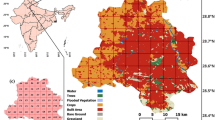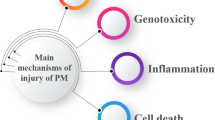Abstract
Numerous studies have shown that extremely low-frequency electromagnetic field (ELF-EMF) by modulating oxidative-antioxidative balance in the cells achieved beneficial and harmful effects on living organisms. The aim of this study was to research changes of both proliferative capacity and redox homeostasis of human lung fibroblast cell line MRC-5 during exposure to ELF-EMF (50 Hz). The human lung fibroblast cell line MRC-5 were exposed to ELF-EMF once a day in duration of 1 h during 24 h (1 treatment 1 h/day), 48 h (2 treatments 1 h/day), 72 h (3 treatments 1 h/day), and 7 days (7 treatments 1 h/day). After 24 h of the last treatment, the proliferative capacity of the cells and the concentrations and activities of the components of the oxidative/antioxidative system were determined: superoxide anion (O2.−), hydrogen peroxide (H2O2), nitric oxide (NO), peroxynitrite (ONOO−), reduced glutathione (GSH), oxidized glutathione (GSSG), superoxide dismutase (SOD), catalase (CAT), glutathione peroxidase (GSH-Px), glutathione reductase (GR), and glutathione-S-transferase (GST). The results of this study show that ELF-EMF may affect a cell cycle regulation of human lung fibroblast cell line MRC-5 through modulation of oxidative/antioxidative defense system. The effects of ELF-EMF on proliferation and redox balance of human lung fibroblast cell line MRC-5 depend on exposure time.




Similar content being viewed by others
References
Agbani EO, Coats P, Mills A, Wadsworth RM (2011) Peroxynitrite stimulates pulmonary artery endothelial and smooth muscle cell proliferation: involvement of ERK and PKC. Pulm Pharmacol Ther 24:100–109
Alvarez B, Radi R (2003) Peroxynitrite reactivity with amino acids and proteins. Amino Acids 25:295–311
Auclair C, Voisin E (1985) Nitroblue tetrazolium reduction. In: Greenwald RA (ed) Handbook of methods for oxygen radical research. CRC Press, Boca Raton, Florida, USA, pp 123–132
Beutler E (1975a) Reduced glutathione (GSH). In: Beutler E (ed) red cell metabolism, a manual of biochemical methods. Grune and Straton, New York, pp 112-114
Beutler E (1975b) Oxidized glutathione (GSSG). In: Beutler E (ed) red cell metabolism, a manual of biochemical methods. Grune and Straton, New York, pp 115-117
Beutler E (1982) Catalase. In: Beutler E (ed) Red cell metabolism, a manual of biochemical methods. Grune and Straton, New York, pp 105–116
Beutler TM, Eaton DL (1992) Glutathione-S-transferases: amino acid sequence comparison classification and phylogenetic relationship. Environ Carcino Ecotox Revs C10:181–203
Calcabrini C, Mancini U, De Bellis R et al (2017) Effect of extremely low-frequency electromagnetic fields on antioxidant activity in the human keratinocyte cell line NCTC 2544. Biotechnol Appl Biochem 64:415–422
Carpenter DO (2013) Human disease resulting from exposure to electromagnetic fields. Rev Environ Health 28:159–172
Chiu J, Dawes IW (2012) Redox control of cell proliferation. Trends Cell Biol 22:592–601
Consales C, Merla C, Marino C, Benassi B (2012) Electromagnetic fields, oxidative stress, and neurodegeneration. Int J Cell Biol 2012:683897
D'Angelo C, Costantini E, Kamal MA, Reale M (2015) Experimental model for ELF-EMF exposure: concern for human health. Saudi J Biol Sci 22:75–84
Djordjevic NZ, Paunović MG, Peulić AS (2017) Anxiety-like behavioural effects of extremely low-frequency electromagnetic field in rats. Environ Sci Pollut Res Int 24:21693–21699
Dröge W (2002) Free radicals in the physiological control of cell function. Physiol Rev 82:47–95
Filomeni G, Rotilio G, Ciriolo MR (2003) Glutathione disulfide induces apoptosis in U937 cells by a redox-mediated p38 MAP kinase pathway. FASEB J 17:64–66
Foyer HC, Wilson HM, Wrightb HM (2018) Redox regulation of cell proliferation: bioinformatics and redox proteomics approaches to identify redox-sensitive cell cycle regulators. Free Radic Biol Med 122:137–149
Glatzle D, Vuilleumier JP, Weber F, Decker K (1974) Glutathione reductase test with whole blood, a convenient procedure for the assessment of riboflavin status in humans. Experientia 30:665–667
Goodman R, Shirley-Henderson A (1991) Transcription and translation in cells exposed to extremely low frequency electromagnetic fields. J Electroanal Chem Interfacial Electrochem 320:335–355
Green LC, Wagner DA, Glogowski J, Skipper PL, Wishnok JS, Tannenbaum SR (1982) Analysis of nitrate, nitrite and [15N]nitrate in biological fluids. Anal Biochem 126:131–138
Habig WH, Pabst MJ, Jakoby WB (1974) Glutathione S-transferase. J Biol Chem 249:7130–7139
Halliwel B, Gutteridge JMC (2007) Free radicals in biology and medicine. Oxford University Press, New York
Hardell L, Sage C (2008) Biological effects from electromagnetic field exposure and public exposure standards. Biomed Pharmacother 62:104–109
Herriges M, Morrisey EE (2014) Lung development: orchestrating the generation and regeneration of a complex organ. Development 141:502–513
Holz O, Zühlke I, Jaksztat E, Müller KC, Welker L, Nakashima M, Diemel KD, Branscheid D, Magnussen H, Jörres RA (2004) Lung fibroblasts from patients with emphysema show a reduced proliferation rate in culture. Eur Respir J 24:575–579
Jones DP, Eklow L, Thor H, Orrenius S (1981) Metabolism of hydrogen peroxide in isolated hepatocytes: relative contributions of catalase and glutathione peroxidase in decomposition of endogenously generated H2O2. Arch Biochem Biophys 210:505–516
Kovacic P, Somanathan R (2010) Electromagnetic fields: mechanism, cell signaling, other bioprocesses, toxicity, radicals, antioxidants and beneficial effects. J Recept Signal Transduct Res 30:214–226
Kurundkar A, Thannickal JV (2016) Redox mechanisms in age-related lung fibrosis. Redox Biol 9:67–76
Liu Y, Liu WB, Liu KJ, Ao L, Cao J, Zhong JL, Liu J (2015) Extremely low-frequency electromagnetic fields affect the miRNA-mediated regulation of signaling pathways in the GC-2 cell line. PLoS One 10:e0139949
Lubos E, Handy DE, Loscalzo J (2008) Role of oxidative stress and nitric oxide in atherothrombosis. Front Biosci 13:5323–5344
Maral J, Puget K, Michelson AM (1977) Comparative study of superoxide dismutase, catalase and glutathione peroxidase levels in erythrocytes of different animals. BBRC 77:1525–1535
Marklund S, Marklund G (1974) Involvement of superoxide anion radical in the autoxidation of pyrogallol and a constituent assay for superoxide dismutase. Eur J Biochem 47:469–479
Markov MS (2007) Pulsed electromagnetic field therapy history, state of the art and future. Environmentalist 27:465–475
Matés JM (2000) Effects of antioxidant enzymes in the molecular control of reactive oxygen species toxicology. Toxicology 153:83–104
Meister A (1992) Biosynthesis and function of glutathione, an essential biofactor. J Nutrit Sci Vitaminol (spec no):1-6
Mosmann T (1983) Rapid colorimetric assay for cellular growth and survival: application to proliferation and cytotoxicity assays. J Immunol Methods 65:55–63
Mueller S, Riedal HD, Stremmel W (1997) Direct evidence for catalase as the predominant H2O2-remaining enzyme in human erythrocytes. Blood 90:4973–4978
Napoli C, Paolisso G, Casamassimi A, al-Omran M, Barbieri M, Sommese L, Infante T, Ignarro LJ (2013) Effects of nitric oxide on cell proliferation: novel insights. J Am Coll Cardiol 62:89–95
Noble PW, Barkauskas CE, Jiang D (2012) Pulmonary fibrosis: patterns and perpetrators. J Clin Invest 122:2756–2762
Pick E, Keisari Y (1980) A simple colorimetric method for the measurement of hydrogen peroxide produced by cells in culture. J Immunol Methods 38:161–170
Radi R, Beckman JS, Bush KM, Freeman BA (1991) Peroxynitrite-induced membrane lipid peroxidation: the cytotoxic potential of superoxide and nitric oxide. Arch Biochem Biophys 288:481–487
Riordan JF, Vallee BL (1972) Nitration with tetranitromethane. In: Hirs CHW, Timasheff SN (eds) Methods in enzymology. Academic Press, New York, pp 515–521
Stadtman TC (1991) Biosynthesis and function of selenocysteine-containing enzymes. J Biol Chem 266:16257–16260
Villalobo A (2006) Nitric oxide and cell proliferation. FEBS J 273:2329–2344
Wang H, Zhang X (2017) Magnetic fields and reactive oxygen species. Int J Mol Sci 18:E2175
Wink DA, Mitchell JB (1998) Chemical biology of nitric oxide: insights into regulatory, cytotoxic, and cytoprotective mechanisms of nitric oxide. Free Radic Biol Med 25:434–456
Wolf FI, Torsello A, Tedesco B, Fasanella S, Boninsegna A, D'Ascenzo M, Grassi C, Azzena GB, Cittadini A (2005) 50-Hz extremely low frequency electromagnetic fields enhance cell proliferation and DNA damage: possible involvement of a redox mechanism. Biochim Biophys Acta 1743:120–129
Funding
This study was supported by the Ministry of Education, Science and Technological Development of Republic of Serbia, Grant No. 173041.
Author information
Authors and Affiliations
Corresponding author
Ethics declarations
Conflict of interest
The authors declare that they have no conflict of interest.
Additional information
Responsible Editor: Lotfi Aleya
Publisher’s note
Springer Nature remains neutral with regard to jurisdictional claims in published maps and institutional affiliations.
Rights and permissions
About this article
Cite this article
Lekovic, M.H., Drekovic, N.E., Granica, N.D. et al. Extremely low-frequency electromagnetic field induces a change in proliferative capacity and redox homeostasis of human lung fibroblast cell line MRC-5. Environ Sci Pollut Res 27, 39466–39473 (2020). https://doi.org/10.1007/s11356-020-10039-0
Received:
Accepted:
Published:
Issue Date:
DOI: https://doi.org/10.1007/s11356-020-10039-0




